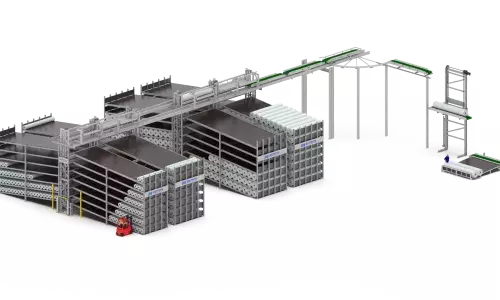Customer’s request
Condor Carpets from the Netherlands wanted a system to automatically transport rolls of tufted carpet from their existing and new production line to their new warehouse. They had the following requirements for the conveyor system, among other things:
- Only sporadic forklift traffic should be required between the 2 production lines and the new warehouse (forklift traffic limited to uncategorised rolls)
- It must be possible to dispense rolls at different locations in the new warehouse
- The rolls have a minimum diameter of 250 mm and a maximum diameter of 1000 mm
- The roll weight is limited to a maximum of 700 kg
- The roll identification label on the head of the roll must always be visible at the collection position in the warehouse
- The system must have the capacity to process rolls coming from 2 production lines that are producing at the same time (1 roll per 30 seconds)
- There should be sufficient automatic storage of rolls to ensure overnight production. The conveyor system should also be able to serve as temporary storage facility for rolls that need to be delivered quickly. This storage avoids the need to use forklifts to place the rolls on warehouse racks
- The system must be able to fit into the existing and new infrastructure and the connection between these 2 buildings
- Automatic destination identification should be possible in the warehouse
- Production downtime should be minimised to only a few days during installation and commissioning
- A back-up system must be provided in the event of a failure to compensate for any downtime on the production lines
- The conveyor system should handle the sometimes delicate rolls with due care (special attention to some transition points between conveyor belts)
- Attention should also be paid to safety, energy consumption and ease of maintenance
Our realisation
We used 44 conveyor belts, 4 swivel belts, one 180° rotation station, 2 roll lifts and 9 warehouse lifts for roll sorting to bridge the distance of more than 450 m between the 2 production lines and the various drop-off positions in the warehouse.
Right after each production line is an ejection position for pushing out the rolls at that position in the event of an emergency so that the production line can continue with production. Several lifts then bring the rolls to the required height. All conveying operations are therefore done at height to avoid interfering with other traffic or activities inside the buildings.
In the new warehouse, rolls are dispensed on 18 downward sloping racks at nine different locations, with each rack consisting of seven superimposed levels.. We can buffer about 1,800 rolls in the system as a result.
When a roll leaves the production line, an image-processing reader automatically scans the barcode on the head of the roll. The MES system sends the destination to the conveyor system. Right before delivery to the warehouse lifts, another scan is performed to check the progress of the roll, on the one hand, and on the other hand to change the destination of the roll, if necessary.
During installation, all new components that did not affect the existing production were first built and tested. After a positive evaluation, the components of the existing conveyor were dismantled and replaced with new ones, which resulted in only a few days of production downtime.
Visualisation of the system can be transferred to a tablet using a separate WiFi network for the machine, enabling a maintenance technician to have look at a problem very locally.
In terms of security, all entrances to lifts and racks are maximally secured with light curtains and locked doors. In addition, during downward movement of the lifts, the energy generated is fed back into the grid.
Related machines
We are happy to help you
Do you have a customised project and would you like to discuss it? Don't hesitate to contact us!



